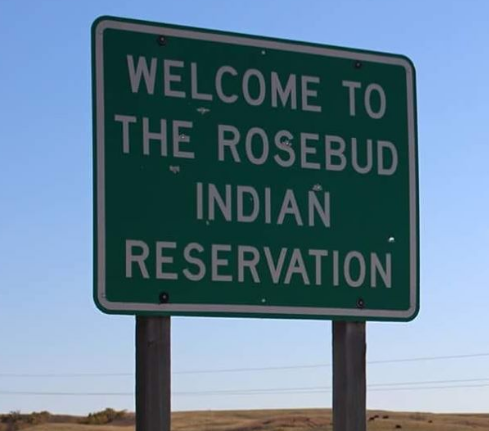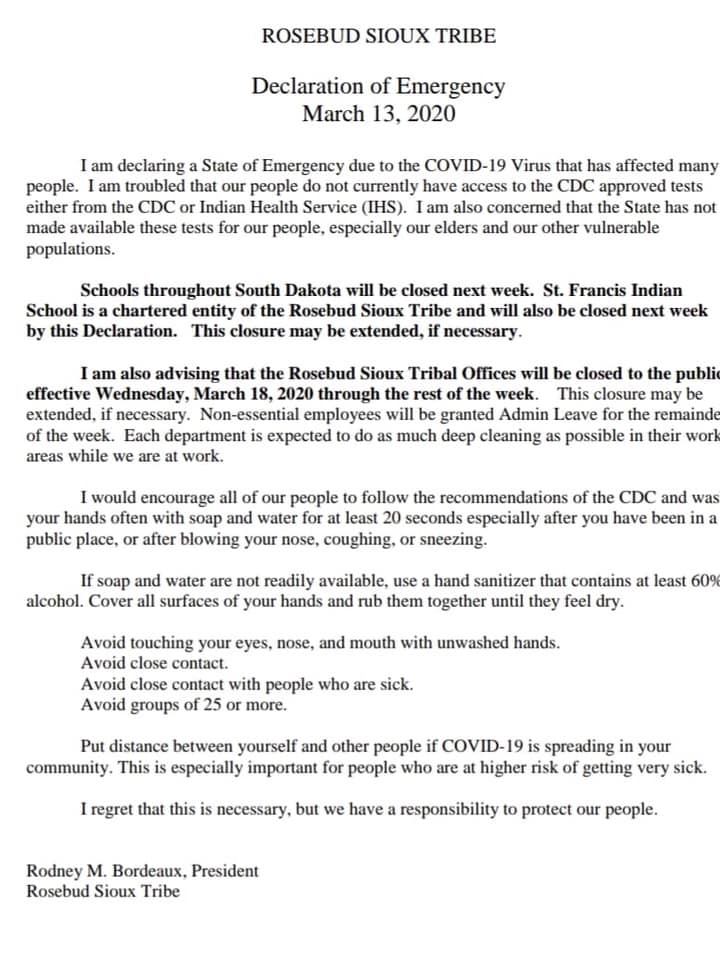
- Details
- By Levi Rickert
ROSEBUD INDIAN RESERVATION — Rosebud Sioux Tribe President Rodney Bordeaux on Wednesday issued a lockdown for the entire Rosebud Indian Reservation in South Dakota beginning at midnight tonight. The lockdown will remain in effect until Sunday, May 17, 2020 at 6 a.m. – CDT.
The action came after Rosebud Sioux tribal leaders learned of 14 active cases of COVID-19 on the reservation.
“I had hoped that this was not necessary. Unfortunately, there were too many people in our community who refused to take precautions of social distancing and the wearing of masks in public and also refused to self-quarantine or take any of this seriously,” Bordeaux said in a video released on Wednesday.
During the announcement, Bordeaux said the tribe will put five checkpoints on state and federal highways that include U.S. 83 and U.S. 18 as well as South Dakota state highway 44. While the checkpoints will be established, he said commercial traffic onto the reservation and non-residents will be able to travel through the reservation and will be instructed not to stop to visit anyone on the reservation.
Businesses will be allowed to remain open on a limited basis between the hours of 10 a.m. to 2 p.m. during the lockdown in order to allow people to get needed supplies. Those needing dialysis treatments also will be allowed to travel to their treatment sites, and medical professionals and their staff will be allowed to travel while performing their official duties.
Bordeaux says his office will develop a list of essential employees who can go to work. Residents must show proof they have medical or dental appointments if they want to leave the reservation and come back during the lockdown.
“The goal of the lockdown is so that we can do the contact tracing that we need to do to work on suppression of the spread of the virus,” he said in a live announcement.
The Rosebud Indian Reservation is located in south central South Dakota on 1,979 square miles with a population of 11,354 in 2017.

More Stories Like This
Native News Weekly (August 25, 2024): D.C. BriefsUS Presidents in Their Own Words Concerning American Indians
Native News Weekly (December 14, 2025): D.C. Briefs
Wounded Knee Massacre Site Protection Bill Passes Congress
Two Murdered on Colville Indian Reservation
Help us defend tribal sovereignty.
At Native News Online, our mission is rooted in telling the stories that strengthen sovereignty and uplift Indigenous voices — not just at year’s end, but every single day.
Because of your generosity last year, we were able to keep our reporters on the ground in tribal communities, at national gatherings and in the halls of Congress — covering the issues that matter most to Indian Country: sovereignty, culture, education, health and economic opportunity.
That support sustained us through a tough year in 2025. Now, as we look to the year ahead, we need your help right now to ensure warrior journalism remains strong — reporting that defends tribal sovereignty, amplifies Native truth, and holds power accountable.
 The stakes couldn't be higher. Your support keeps Native voices heard, Native stories told and Native sovereignty defended.
The stakes couldn't be higher. Your support keeps Native voices heard, Native stories told and Native sovereignty defended.
Stand with Warrior Journalism today.
Levi Rickert (Potawatomi), Editor & Publisher

